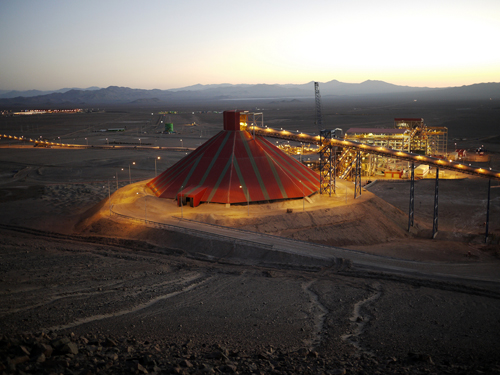
Copper fundamentals are highly buoyant. Demand for copper is increasing at over half a million tones annually, most of it driven by China, which consumes 20 percen of global supply. Demand for copper shows no sign of levelling off in the opinion of researchers at Yale, who calculated from 2006 consumption figures that global demand for copper would exceed the amount extractable from the ground by 2100.
Codelco (Corporación Nacional del Cobre de Chile or the National Copper Corporation of Chile) was founded in 1976, five years after the Chilean government nationalized the entire copper mining industry. Codelco grouped the existing deposits into a single mining, industrial and commercial corporation and today it is the biggest copper producer in the world controlling a tenth of known global reserves. Codelco has more than $20.835 billion in assets and in 2011 its equity totalled $6.065 billion. In the same year the company produced 1.79 million metric tons of refined copper - over ten percent of world copper production. And at today’s investment levels it estimates it has the capacity to maintain current production rates for a further 70 years at least.
But that can’t be done without strategic investment, and a number of specific projects are being targeted. The Andina Division is located at 3,000 metres above sea level a little to the north of the Chilean capital Santiago and at the base of the chain of operations that is strung out along the Andes in the northern half of Chile. It is a combined open-pit and underground mining operation. Andina Expansion Phase I project involved expanding its mining and processing capacity from 72,000 tonnes per day to an average 94,000 tonnes per day and was completed in 2012 at a cost of $1.2 billion. But this was just the first part of a major expansion programme aimed at increasing annual production at the mine to around 680,000 tonnes over the next 30 years. Andina Phase II is truly a megaproject involving the shifting of more than half a million tonnes of ore daily once it is completed in 2018 – by then Codelco will have invested $6.27 billion at Andina.
Chuquicamata, 1,600 kilometres to the north of Santiago near the port of Antofagasta, is an open pit operation that has been mined for a century and is close to being mined out. But lying at a deeper level Codelco estimates there is a further 1.7 billion tonnes of copper ore. So from 2019 and for the next 50 years after that Chuquicamata will operate as an underground mine, a change that will cost $3.8 billion. The method to be used here is block caving, which involves driving access tunnels below fragmented ore that is crumbly enough to flow under gravity to the waiting trucks. It is an increasingly favoured way of dealing with high volume, relatively low grade ore deposits (Chuquicamata comes in at around 0.7, with molybdenum at around 500 ppm) as long as the geology is right.
Going underground at Chuquicamata will give Codelco potential production of 340,000 tonnes of fine copper and more than 18,000 tonnes of fine molybdenum a year from an expected throughput of 140,000 tonnes of ore a day. During its construction it will create a maximum 3,767 jobs. From 2019, the operation will provide work for up to 4,837 employees. It is being designed to the highest safety standards, and will have a very positive environmental impact – by going underground Chuquicamata will reduce its dust emissions by no less than 97 percent.
Another older mine, this time an underground operation, is the El Teniente property that traces its origins as far back as 1819, though commercial mining has been done there since 1905. The existing mine near Rancagua south of Santiago is the world’s largest underground copper mine containing 2,400 kilometres of tunnels and lies at an altitude of nearly two kilometres. The new mine level (NML) will involve cutting a massive two million square metre slice deeper into the mountain, accessed by two parallel nine-kilometre tunnels, one for access and the other for the conveyor that will take the ore out to the concentrator site.
Between 2011 when construction started and its commissioning in 2017 the project will build 98,450 metres of tunnels and 3,454 metres of vertical ventilation shafts and transfer shafts. Most of the $3.5 billion investment will go on this underground work: surface work includes the construction of a new, faster road from Rancagua with associated tunnels and bridges – this will make life easier for the mine’s 5,500 employees. To a great extent the new El Teniente operations will be remotely operated from a control room at Rancagua, 50 kilometres away from the mine. The NML project adds 2.02 billion tonnes of reserves, at a 0.86 percent copper grade. Codelco estimates that at over 50 years of operation starting from the end of 2017 it could produce more than 17 million tonnes of fine copper.
In all Codelco’s current portfolio involves 30 studies and projects aimed at keeping the Chilean national mining giant in a leadership position globally, not only in terms of production numbers but also in environmental, technological and safety best practices right across the value chain. Emissions, water usage and energy conservation are all at the heart of Codelco’s strategy – however it seems inconceivable that the demand for Chilean copper could fail to justify the massive expansion projects that are in the pipeline. The company’s recently appointed CEO Thomas Keller has been busy courting world markets and especially the Chinese market which according to Keller accounts for 40 percent of world demand an can be expected to grow between five and seven percent annually based on China’s predicted GDP growth of up to eight percent.
Written by John O’Hanlon, research by Richard Halfhide



 Codelco-Americas.Mining-Mar13-Bro-s.pdf
Codelco-Americas.Mining-Mar13-Bro-s.pdf









